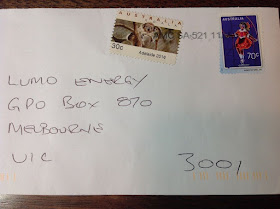But these days, casual finds by collectors and non-collectors are more likely to end up on the eBay internet auction site. More people use it (whether for stamps or other goods), more people access it - around the world - and more publicity is generated.
Back in November, Australia Post was given permission to raise the postage rate from 70c to $1 (a massive hike, which recalls Royal Mail's jump from 46p to 60p). [At the same time a new Priority letter service was introduced - a bit like our 1st class - costing $1.50, but that's another matter!]
Plenty of time to print new $1 stamps, and arrange for supplies of 30c stamps to supplement exisitng letter rate stamps, one would think. (Australia hasn't grasped the concept of NVIs yet.) But close to the end of the year the new 30c stamps were still being distributed and sure enough when the rates increased on 4 January, there were shortages.
Luckily, Adelaide GPO still had the 22 year old Counter Printed Stamp ("CPS") machine that they have used for decades to produce special overprints at some smaller stamp shows in the Adelaide region, and used that. The base stamps, like our Post and Go stamps, are produced for the value and other text to be added when needed. In the 1990s the machines were used all over Australia and the stamps appeared with text for shows such as Philakorea, Austrapex 95, Singapore 95, Hong Kong 97, Melbourne GPO, etc. The stamps in use this year have the year 1994 micro-printed in the design - these have been gathering dust for a long time!
So, with a machine available to print stamps on demand, what would be more obvious than to print extra stamps locally until such time as supplies of the ordinary 30c definitives were delivered. And that's what they did. To alleviate the shortfall the Adelaide GPO printed up an unknown quantity of 30c Counter-Printed Stamps with 'Adelaide 2016' text.
The news broke on the Stampboards forum on 17 January.
The stamps were distributed to Adelaide metropolitan corporate post shops that reordered 30c stamps that week and these Corporates also re-distributed supplies to Licensed Post Offices in their immediate area. The issue is a retail product, and NOT a philatelic product, and therefore No FDI covers were, or will be, produced. To reinforce the treatment, as retail products the stamps were distributed in packs of 100 stamps, usually made up of strips of five as they are easier to count. Adelaide GPO had them in strips of five or ten and the more collectable strips of six (different designs) could only be sourced from those strips of ten. As distribution was only to offices that ran out of 30c stamps during a four day period only they will be worth chasing. More on Stampboards.
The first mint set appeared on eBay on 20 January. For a face value of A$1.80 (90p) it sold for a remarkable A$1051.11 (£522.80). Here's a single
But of course that was only the start. This emergency issue made headlines in the mainstream media, newspapers, radio and television - Sydney Morning Herald, Canberra Times, ABC Radio, etc. So more non-collectors in the Adelaide area looked in their wallets and purses and out came more. A single stamp on a cover with a clear date attracted 67 bids which pushed it up to A$1694.58 - £842!!!
UPDATE 11 FEBRUARY
This piece of kiloware has one of the emergency stamps used on the first day of availability, 6 January 2016, and sold for A$2,025 - that's £1,420 !!
Collectors of Australian stamps are much more aware of the value of building up a modern postal history collection than those of most other countries. Sure, some collectors concentrate on a particular stamp or issue and find genuine commercial uses for as many values and destinations as they can, but those are the exception.
Of course it helps that the Australian Commonwealth Specialists' Catalogue lists the purposes for which the stamps of those rates were issued, and values each and every special stamp on cover. Specialists recognise a genuine use to an uncommon destination as being scarcer and more desirable than to common destinations, and are prepared to pay more for them to enhance their collections.
So, if you have friends in Adelaide who have written recently, take another look at the stamps on the envelope. And if you have access to Australia kiloware, look closely in the coming months because most of these - like the example above - were used by ordinary people on ordinary letters.
Now only if we could start collecting similarly in the UK. Certainly the non-philatelic use of modern higher-value stamps issued by Royal Mail is not commonly collected. For people who do collect stamps on cover, I shall be offering some like this later this year.
£1.60 and 2 x Waddington(?) 4d on Special Delivery London - Bury St Edmunds February 1988
Meanwhile, I have some Australian stamps to look at!
Thanks to Glen Stephens and all at Stampboards for images and text which produced this article.








Great summation...off to check my mail box!
ReplyDeleteCarla
Will these in years to come be considered as the modern day equivalent of the British Guiana 1c Magenta?
ReplyDeleteNo.
DeleteActually, the minister didn't approve the rate rise until late December. The Wildflower issue released on 14 December, were issued before the rates were signed off on. Australia Post took a risk with this, which possibly explains the size of the stamps being the same as regular commemoratives. Also, the booklets don't have any rates tables on the back. The first rate tables appeared on the Occasions issue released on 25 January.
ReplyDeleteThanks Chris. It's a wonderful story, and it's great to see ordinary people taking an interest and being able to benefit from collectors' desires to get these. For some of them it will be like a small lottery win.
Delete